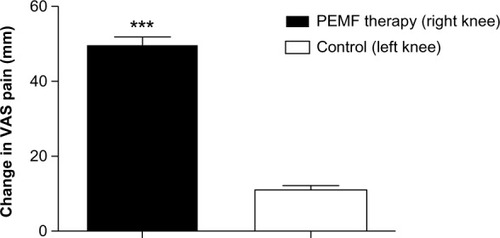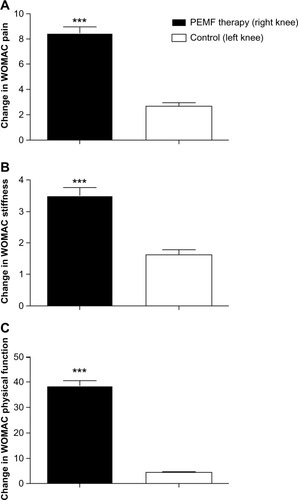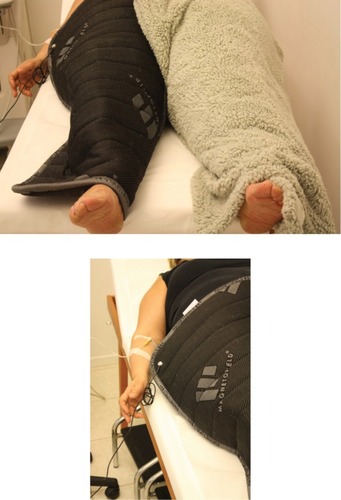Abstract
Background
Pulsed electromagnetic field (PEMF) therapy has shown promising therapeutic effectiveness on bone- and cartilage-related pathologies, being also safe for management of knee osteoarthritis.
Aim
The aim of this study was to investigate the clinical efficacy of a PEMF device for management of knee osteoarthritis in elderly patients.
Materials and methods
A total of 33 patients were screened, and 28 patients, aged between 60 and 83 and affected by bilateral knee osteoarthritis, were enrolled in this study. They received PEMF therapy on the right leg for a total of three 30-minute sessions per week for a period of 6 weeks, while the left leg did not receive any treatment and served as control. An intravenous drip containing ketoprofen, sodium clodronate, glucosamine sulfate, calcitonin, and ascorbic acid, for a total volume of 500 mL, was administered during PEMF therapy. At baseline and 3 months post-PEMF therapy, Visual Analog Scale (VAS) was used to assess knee pain and Western Ontario McMaster Universities Osteoarthritis Index (WOMAC) was used to measure knee pain, stiffness and physical function.
Results
Changes in VAS and WOMAC scores were calculated for both knees as baseline minus post-treatment. A two sample Student’s t-test, comparing change in knee-related VAS pain for PEMF-treated leg (49.8 ± 2.03) vs control leg (11 ± 1.1), showed a significant difference in favor of PEMF therapy (P < 0.001). A two sample Student’s t-test comparing change in knee-related WOMAC pain, stiffness, and physical function for PEMF-treated leg (8.5 ± 0.4, 3.5 ± 0.2, 38.5 ± 2.08, respectively) vs control leg (2.6 ± 0.2; 1.6 ± 0.1; 4.5 ± 0.5 respectively), also showed a significant difference in favor of PEMF therapy (P < 0.001). No adverse reactions to therapy were observed.
Conclusion
The present study shows that PEMF therapy improves pain, stiffness and physical function in elderly patients affected by knee osteoarthritis.
Introduction
Osteoarthritis (OA) is a degenerative joint disease frequently affecting the knee and afflicting the constantly increasing elderly population.Citation1,Citation2 Knee OA symptoms include pain, stiffness, and functional limitation, leading to loss of autonomy and poor quality of life in patients affected by this disease.Citation3 Nowadays, various treatment options are available for the management of this condition. They include: nonsteroidal anti-inflammatory drugs (NSAIDs) for pain management;Citation4 bisphosphonates to decrease pain and improve functionality preserving the structural integrity of subchondral bone;Citation5 therapeutic exercise;Citation6 viscosupplementation with hyaluronic acid alone or in combination with bisphosphonates or NSAIDs to improve pain and functional activityCitation7–Citation9 since hyaluronic acid improves articular cartilage degeneration and decreases osteophyte formation, as showed by experimental studies using OA models.Citation10,Citation11 These treatment modalities are effective in reducing pain and inflammation, but their long-term administration is associated with a high incidence of side effects or may not be applicable to the elderly.Citation12 Building upon these foundations, there is an urgent need for alternative therapies for this pathological condition. Pulsed electromagnetic field (PEMF) therapy has proved to be safe and has also shown promising therapeutic effectiveness on bone- and cartilage-related pathologies, including knee and cervical spine OA.Citation13–Citation18
Aim
The aim of this study was to investigate the clinical efficacy of a PEMF device for management of knee OA in elderly patients.
Materials and methods
Patients
A total of 33 patients were screened, and 28 patients, aged between 60 and 83 (69.9 ± 1.5 [mean ± Standard Error of the Mean {SEM}]) and affected by bilateral knee OA, were enrolled in this study. All patients signed the informed consent. The protocol was planned and applied in agreement with the Declaration of Helsinki and was approved by the Institutional Review Board at the Poliambulatorio del Secondo Parere (Modena, Italy), where the procedure was performed.
Inclusion/exclusion criteria
The inclusion criteria for this study were a diagnosis of bilateral knee OA according to the Diagnostic and Therapeutic Criteria Committee of the American Rheumatism Association,Citation19 recurrent joint pain for at least a year prior to treatment, and daily pain in the knee ≥30 mm, as assessed by a 1–100 mm Visual Analog Scale (VAS). The exclusion criteria were: unilateral knee OA, intra-articular administration of drugs to the affected knees within 6 months before the study, systemic corticosteroid therapy or physiotherapy (iontophoresis with anti-inflammatory drugs, soft [not heating] laser, and ultrasound therapy) in the previous 6 weeks, and knee pain due to malignant, autoimmune and inflammatory pathologies or resulting from defective pathologies of the knee.
Therapeutic regimen
PEMF therapy was performed using the Magnetofield device (F&B International, Parma, Italy). The applicators were held at the sides of the knee by a velcro band. The medical device combines low and high frequencies by means of 2 local devices in the shape of a hemisphere. The low-frequency field releases an intensity between 50 and 100 Gauss. The high-frequency field develops an intensity between 60 and 80 decibel relative to 1 volt (dBV)/meter (m). Low frequency takes the form of a square wave with frequency comprised between 6 and 100 Hz and duty cycle comprised between 30% and 70%. The high frequency also takes the form of a square wave, which is made up of a modulating and a carrier wave (continuous modulation). The modulating wave frequency varies between 100 and 5000 Hz, with duty cycle constant at 50%. The carrier-wave frequency varies between 20 and 30 MHz, with duty cycle at 50%.
In the present study, the patients underwent two consecutive therapeutic regimens: (1) 6÷100 Hz (low frequency) and 500÷2000 Hz (high frequency) for 15 minutes, and (2) 6÷100 Hz (low frequency) and 100÷5000 Hz (high frequency) for 15 minutes. A total of three 30-minute sessions per week for a period of 6 weeks were administered to each patient. The right leg was treated with PEMF therapy, while the left leg did not receive any treatment and was used as control (). An intravenous drip, containing ketoprofen (4 mL [160 mg/mL]; Dompè Farmaceutici, Milan, Italy), sodium clodronate (10 mL [30 mg/mL]; Abiogen Pharma, Pisa, Italy), glucosamine sulfate (1 mL [1.5 mg/mL]; Rottapharm, Monza, Italy), calcitonin (1 mL [100 Ui/mL]; Sandoz Industrial Products, Trento, Italy), and ascorbic acid (5 mL [0.2 g/mL]; Bayer, Milan, Italy), was administered while patients were receiving PEMF therapy.
Assessment of results
VAS and the Western Ontario McMaster Universities Osteoarthritis Index (WOMAC) have been extensively used in clinical investigations to assess pain, stiffness, and physical function in patients affected by knee OA.Citation20–Citation22 In our study, VAS (0–100 mm, 0 = no pain, 100 = maximum pain) and WOMAC (subscore 0–20, 0 = minimum pain, 20 = maximum pain) were used to measure knee-related pain at baseline and at 3 months post-PEMF therapy. Furthermore, WOMAC was also used to determine knee-related stiffness (subscore 0–8, 0 = minimum stiffness, 8 = maximum stiffness) and physical function (subscore 0–68, 0 = minimum physical function, 68 = maximum physical function).
Statistical analysis
All data are represented as the means ± SEM and were analyzed using GraphPad Prism 5.04 (GraphPad Software Inc., San Diego, CA, USA). Changes in VAS and WOMAC scores were calculated for both knees as baseline minus post-treatment. An unpaired two-sample Student’s t-test was used to compare change in knee-related VAS and WOMAC scores for PEMF-treated leg (mean ± SEM) vs control leg (mean ± SEM). P < 0.05 was considered significant.
Results
A total of 28 patients participated in the present study. At baseline, no significant difference was observed in mean VAS and WOMAC pain and mean WOMAC stiffness and physical function between left and right knee. VAS pain in the right knee changed from a baseline of 78.2 ± 1.2 to 28.4 ± 1.2 mm at 3 month follow-up. VAS pain in the control knee changed from a baseline of 78.2 ± 1.9 to 67.2 ± 1.7 mm at 3 month follow-up. In the right knee, WOMAC pain, stiffness, and physical function changed from baseline values of 15.6 ± 0.3, 6.3 ± 0.2, and 54.4 ± 1.8 to 7.1 ± 0.3, 2.8 ± 0.1, and 15.8 ± 0.9 at 3 month follow-up, respectively. In the control knee, WOMAC pain, stiffness, and physical function changed from baseline values of 15.3 ± 0.3, 6.3 ± 0.2, and 54.5 ± 1.8 to 12.9 ± 0.4, 4.7 ± 0.2, and 50.03 ± 1.8 at 3 month follow-up, respectively.
At 3 month follow-up, knee-related VAS pain significantly improved in PEMF-treated leg (49.8 ± 2.03) if compared with control leg (11 ± 1.1; P < 0.001, ). At 3 month follow-up, knee-related WOMAC pain, stiffness, and physical function significantly improved in PEMF-treated leg (8.5 ± 0.4, 3.5 ± 0.2 and 38.5 ± 2.08, respectively) if compared with control leg (2.6 ± 0.2, 1.6 ± 0.1 and 4.5 ± 0.5, respectively; P < 0.001, ). No adverse reactions to therapy were observed.
Figure 2 Change in knee-related VAS pain for PEMF-treated leg vs control leg. Data are presented as the means ± SEM.
Note: ***P < 0.001.
Abbreviations: VAS, Visual Analog Scale; PEMF, pulsed electromagnetic field; SEM, Standard Error of the Mean; vs, versus.

Figure 3 Change in knee-related WOMAC pain (A), stiffness (B), and physical function (C) for PEMF-treated leg vs control leg. Data are presented as the means ± SEM.
Abbreviations: PEMF, pulsed electromagnetic field; SEM, Standard Error of the Mean; WOMAC, Western Ontario McMaster Universities Osteoarthritis Index; vs, versus.

Discussion
Experimental studies had previously shown that PEMF therapy produces an anabolic effect on the two key cell types in the skeletal system, ie, osteoblasts and chondrocytesCitation23–Citation26 that are involved in experimental and clinical OA. Furthermore, PEMF therapy possesses healing properties at the cellular level.Citation27–Citation31 In the present study we investigated the efficacy of PEMF therapy for management of knee OA-related pain, stiffness and physical function in elderly patients. We observed a significant improvement in all the above mentioned endpoints at the 3-month follow-up in the knee receiving PEMF therapy, if compared to the control knee without adverse events. Previous studies show contrasting results on the efficacy of PEMF therapy in the management of knee OA-related symptoms. Positive results, consistent with a significant improvement in activities of daily living, stiffness and pain following PEMF therapy, were reported in 83 patients affected by knee OA, if compared with control subjects at 6- and 12-week follow-up following a 6-week therapy.Citation32 This evidence was confirmed by another study involving 34 patients affected by early knee OA, who experienced a 50% decrease in VAS pain starting at day 1 and persisting up to day 42.Citation33 Findings from Fischer and coworkers showed positive results in 71 knee OA patients who underwent low-frequency PEMF therapy for 6 weeks.Citation34 Patients had an increase in mobility and walking distance test, with long-term analgesic and functional effects even at 4 weeks after the end of treatment.Citation34 A significant improvement in WOMAC score was also observed in 75 patients affected by knee OA, who received a 6-week PEMF therapy.Citation35
Trock and colleagues also reported an improvement in pain and functional performance in patients affected by knee OA undergoing PEMF therapy for about 1 month, if compared to control group.Citation15 In opposition to the studies mentioned above, Ozgüçlü and coworkers performed a study involving 40 patients undergoing PEMF therapy for 2 weeks and found no differences between sham and treated group concerning WOMAC pain, stiffness, and physical function scores.Citation36 Ay and Evcik observed a significant improvement in pain in 55 patients affected by knee OA after hot pack/therapeutic ultrasound/PEMF therapy, but this improvement was also present in the sham group after five sessions per week for 2 weeks.Citation37 In our study, we observed a slight decrease in VA S and WOMAC pain, stiffness, and physical function in the control knee likely due to the intravenous drip. Therefore, a therapy combining PEMF therapy and an intravenous drip containing ketoprofen, sodium clodronate, glucosamine sulfate, calcitonin and ascorbic acid may be helpful to provide increased and accelerated relief from knee OA-related symptoms.
Conclusion
PEMF therapy produces a significant benefit in terms of reduction in knee-related pain, stiffness, and physical function in elderly patients with knee OA. Further studies need to be designed to determine effectiveness of PEMF therapy in the long-term follow-up and clarify its mechanism.
Acknowledgments
The authors contributed equally to this work. This article was not supported by grants. Statistical support was provided by the Applied Statistics Lab (ASL) in cooperation with the Center for Clinical and Translational Science (CCTS). The CCTS is supported by grant number UL1TR000117.
Disclosure
The authors certify that there is no conflict of interest with any financial organization regarding the material discussed in the manuscript.
References
- MichaelJWSchlüter-BrustKUEyselPThe epidemiology, etiology, diagnosis, and treatment of osteoarthritis of the kneeDtsch Arztebl Int2010107915216220305774
- IannittiTPalmieriBInflammation and genetics: an insight in the centenarian modelHum Biol201183453155921846209
- FaryRECarrollGJBriffaTGGuptaRBriffaNKThe effectiveness of pulsed electrical stimulation (E-PES) in the management of osteoarthritis of the knee: a protocol for a randomised controlled trialBMC musculoskeletal disorders200891818241355
- BennellKLHunterDJHinmanRSManagement of osteoarthritis of the kneeBMJ2012 Jul 30345e493410.1136/bmj.e493422846469
- IannittiTRosiniSLodiDFredianiBRottigniVPalmieriBBisphosphonates: focus on inflammation and bone lossAm J Ther201219322824622549638
- RoosEMJuhlCBOsteoarthritis 2012 year in review: rehabilitation and outcomesOsteoarthritis Cartilage201220121477148322960093
- PalmieriBRottigniVIannittiTPreliminary study of highly cross-linked hyaluronic acid-based combination therapy for management of knee osteoarthritis-related painDrug Des Devel Ther20137712
- IannittiTLodiDPalmieriBIntra-articular injections for the treatment of osteoarthritis: focus on the clinical use of hyaluronic acidDrugs R D2011111132721142290
- IannittiTRottigniVPalmieriBA pilot study to compare two different hyaluronic acid compounds for treatment of knee osteoarthritisInt J Immunopathol Pharmacol20122541093109823298499
- IannittiTElhensheriMBingölAOPalmieriBPreliminary histopathological study of intra-articular injection of a novel highly cross-linked hyaluronic acid in a rabbit model of knee osteoarthritisJ Mol Histol2013444219120110.1007/s10735-012-9457-423389746
- LiPRaitchevaDHawesMMoranNYuXWangFMatthewsGLHylan G-F 20 maintains cartilage integrity and decreases osteophyte formation in osteoarthritis through both anabolic and anti-catabolic mechanismsOsteoarthritis Cartilage20121120111336134610.1016/j.joca.2012.07.00422809835
- BraundRAbbottJHRecommending NSAIDs and paracetamol: a survey of New Zealand physiotherapists’ knowledge and behavioursPhysiother Res Int2011161434921110412
- AssiotisASachinisNPChalidisBEPulsed electromagnetic fields for the treatment of tibial delayed unions and nonunions. A prospective clinical study and review of the literatureJ Orthop Surg Res201272422681718
- BoopalanPRArumugamSLivingstonAMohantyMChittaranjanSPulsed electromagnetic field therapy results in healing of full thickness articular cartilage defectInt Orthop201135114314820340017
- TrockDHBolletAJDyerRHJrFieldingLPMinerWKMarkollRA double-blind trial of the clinical effects of pulsed electromagnetic fields in osteoarthritisJ Rheumatol19932034564608478852
- TrockDHBolletAJMarkollRThe effect of pulsed electromagnetic fields in the treatment of osteoarthritis of the knee and cervical spine. Report of randomized, double blind, placebo controlled trialsJ Rheumatol19942110190319117837158
- van BergenCJBlankevoortLde HaanRJPulsed electromagnetic fields after arthroscopic treatment for osteochondral defects of the talus: double-blind randomized controlled multicenter trialBMC Musculoskelet Disord2009108319591674
- ZizicTMHoffmanKCHoltPAThe treatment of osteoarthritis of the knee with pulsed electrical stimulationJ Rheumatol1995229175717618523357
- AltmanRAschEBlochDDevelopment of criteria for the classification and reporting of osteoarthritis. Classification of osteoarthritis of the knee. Diagnostic and Therapeutic Criteria Committee of the American Rheumatism AssociationArthritis Rheum1986298103910493741515
- IannittiTRottigniVPalmieriBA pilot study to compare two different hyaluronic acid compounds for treatment of knee osteoarthritisInt J Immunopathol Pharmacol20122541093109823298499
- BaronGTubachFRavaudPLogeartIDougadosMValidation of a short form of the Western Ontario and McMaster Universities Osteoarthritis Index function subscale in hip and knee osteoarthritisArthritis Rheum200757463363817471534
- HughesRCarrAA randomized, double-blind, placebo-controlled trial of glucosamine sulphate as an analgesic in osteoarthritis of the kneeRheumatology200241327928411934964
- AaronRKBoyanBDCiomborDMSchwartzZSimonBJStimulation of growth factor synthesis by electric and electromagnetic fieldsClin Orthop Relat Res2004419303715021128
- De MatteiMCarusoAPezzettiFEffects of pulsed electromagnetic fields on human articular chondrocyte proliferationConnect Tissue Res200142426927911913771
- DinizPSoejimaKItoGNitric oxide mediates the effects of pulsed electromagnetic field stimulation on the osteoblast proliferation and differentiationNitric Oxide200271182312175815
- PezzettiFDe MatteiMCarusoAEffects of pulsed electromagnetic fields on human chondrocytes: an in vitro studyCalcif Tissue Int199965539640110541767
- CiomborDMAaronRKWangSSimonBModification of osteoarthritis by pulsed electromagnetic field – a morphological studyOsteoarthritis Cartilage200311645546212801485
- De MatteiMPaselloMPellatiAEffects of electromagnetic fields on proteoglycan metabolism of bovine articular cartilage explantsConnect Tissue Res2003443–415415914504035
- FiniMGiavaresiGTorricelliPPulsed electromagnetic fields reduce knee osteoarthritic lesion progression in the aged Dunkin Hartley guinea pigJ Orthop Res200523489990816023006
- FiniMTorricelliPGiavaresiGEffect of pulsed electromagnetic field stimulation on knee cartilage, subchondral and epyphiseal trabecular bone of aged Dunkin Hartley guinea pigsBiomed Pharmacother2008621070971517459652
- RogachefskyRAAltmanRDMarkovMSCheungHSUse of a permanent magnetic field to inhibit the development of canine osteoarthritisBioelectromagnetics200425426027015114635
- ThamsborgGFlorescuAOturaiPFallentinETritsarisKDissingSTreatment of knee osteoarthritis with pulsed electromagnetic fields: a randomized, double-blind, placebo-controlled studyOsteoarthritis Cartilage200513757558115979009
- NelsonFRZvirbulisRPillaAANon-invasive electromagnetic field therapy produces rapid and substantial pain reduction in early knee osteoarthritis: a randomized double-blind pilot studyRheumatol Int [Epub March 27, 2012]
- FischerGPelkaRBBarovicJ[Adjuvant treatment of knee osteoarthritis with weak pulsing magnetic fields. Results of a placebo-controlled trial prospective clinical trial.]Z Orthop Ihre Grenzgeb20051435544550 German16224674
- PipitoneNScottDLMagnetic pulse treatment for knee osteoarthritis: a randomised, double-blind, placebo-controlled studyCurr Med Res Opin200117319019611900312
- OzgüçlüECetinACetinMCalpEAdditional effect of pulsed electromagnetic field therapy on knee osteoarthritis treatment: a randomized, placebo-controlled studyClin Rheumatol201029892793120473540
- AySEvcikDThe effects of pulsed electromagnetic fields in the treatment of knee osteoarthritis: a randomized, placebo-controlled trialRheumatol Int200929666366619015858
